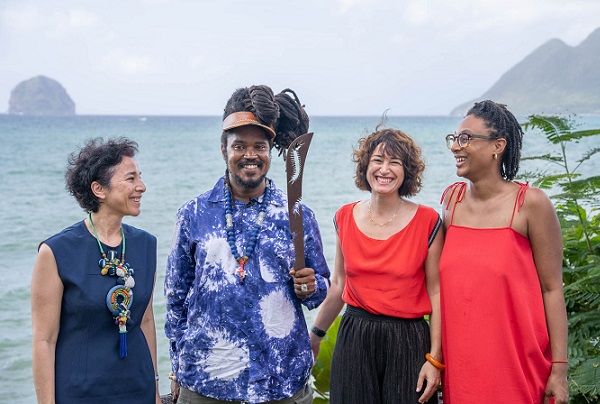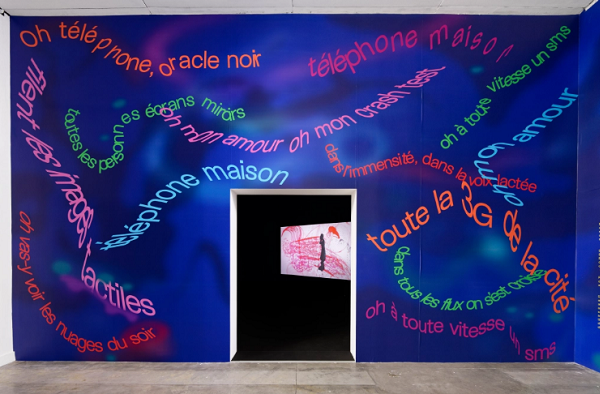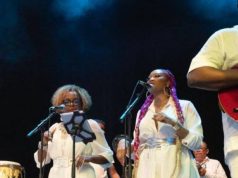
In “Lexique artistique de Julien Creuzet,” Dominique Brebion (AICA Caraïbe du Sud) reviews Martinican artist Julien Creuzet and his aesthetic discourse. Here are translated excerpts:
At thirty-seven years old, Julien Creuzet, visual artist from the Caribbean diaspora, will take over the French Pavilion of the sixtieth Venice Biennale. Born in 1986, Julien Creuzet grew up in Martinique. A graduate of the Caen School of Fine Arts, the Post-Diplôme des Beaux-Arts de l’Académie de Lyon, and the Fresnoy-Studio national des arts contemporains, he combines sculpture, poetry, video and sound. He deploys work of which hybridization is one of the essential drivers. Confronting history, representations, and social realities from here and elsewhere, he offers a work in which poetry and politics, found objects and technological devices combine. Winner of the Marcel Duchamp Prize in 2021, he has exhibited, among others, at the Palais de Tokyo, Manifesta 13, Museum of Modern Art in Paris, Lafayette Anticipations, Biennale de Lyon, Centre Pompidou, Biennale des Rencontres de Bamako, and the Dakar Biennale of Contemporary African Art.
Last February 6, Maison d’Edouard Glissant in Diamant, Martinique, welcomed the French Institute, Julien Creuzet, and his two curators, Céline Kopp and Cindy Sissokho, for the press conference to launch the French Pavilion.
Exhibition: An exhibition is the connection of several forms. The exhibition is thought of as a whole, like a story, like an atmosphere, like fiction. It tells a story, and this story can take the form of fiction. A set of shapes is proposed. The space is designed and brought to life with different points of view.
An exhibition is a milestone. “Today I am on this little rock, tomorrow I will be on another. I continue on my way. We’ll see what happens next. »
Shapes: The forms created by Julien Creuzet emancipate themselves from standardized forms, from pre-established or pre-existing categories. Composite, three-dimensional, hybrid, precariously balanced, mysterious, they are born from the collecting and recycling of natural or manufactured materials.
Their intertwining through the gaze establishes between them shifting links and secret connections that change depending on the point of view and induce new readings.
“I create forms that resist definition. I seek to question a form and understand what it means to push the limits and the story it tells. I create complex sets in which we may travel mentally.”
Materials: Julien Creuzet creates from a broad variety of sometimes anachronistic materials. Some are integrated immediately; others remain in the studio for years. “I need to understand these materials. I need to understand why this rope is braided this way, and to do that I need to distress it. And by de-stressing it, I obtain material.”
There are simple materials: rope, wood, textile fiber, paper, metal, fabric; everyday objects: coffee lids, crisps bags, Ikea wooden shelf, cigar, Coca Cola bottle; misused everyday objects: screens and cell phones; recurring elements: wooden shelves, shells, Murano glass, annatto seeds; fragments of the landscape of Martinique: polished stones from Saint-Pierre Bay, leaves from the Forest of the Alma River. [. . .]
Hybridization and porosity: The specificity of the medium, the boundaries between mediums do not exist for Julien Creuzet. “I don’t believe in specialization. I believe in the permeation of all disciplines to allow us to expand our repertoire of forms. I consider writing like music as a medium, in the same way as photography, virtual reality, sculpture, drawing. Collaborating with choreographers, musicians, designers and thinkers to generate work that more closely resembles a film, a play or an album interests me. I really like mixing disciplines to form an ecosystem.”
Julien Creuzet’s artistic practice abolishes the boundaries between mediums and deconstructs the notions of work and exhibition.
Poetry and writing: Writing is a way of not reducing form only to the visible.
“I write texts because I feel a real need to do so. I don’t use paper and pen, I often write on my smartphone, then on my computer, and I consider it a pure material. Then, there is the moment when I generate shapes, so I try to bring together these different moments at the same time. Poetry allows us to convey imagination, complexity, things that may be difficult to formulate directly.” [. . .]
Title: The titles are poems, forms in their own right. They are works of art.
“In my work, a form is never alone, it is always accompanied by a text. The sound pieces are rather extended rap which frees itself from construction codes. The titles add a new dimension. Thus, a poetic title of several pages accompanying a sculpture allows this form to exist with a history endowed with a long and multiple interpretation. But these texts break the explanation of the work: they are not there to say what the forms are. The text is a story that allows this form to be injected into a broader world.” [. . .]
Excerpts translated from the French by Ivette Romero. For full, original article and photo gallery, see https://aica-sc.net/2024/02/24/lexique-artistique-de-julien-creuzet/
[Shown above: First, photo by Nicolas Derné; press conference Eva Nguyen Binh, Julien Creuzet, with curators Céline Kopp and Cindy Sissokho. Second: Photo by Aurélien Mole (Graphisme par Alliage. © Magasin CNAC), Julien Creuzet’s « Oh téléphone, oracle noir (…) », exhibition view at Magasin CNAC, Grenoble, 17 November 2023 to 26 May 2024.]
In “Lexique artistique de Julien Creuzet,” Dominique Brebion (AICA Caraïbe du Sud) reviews Martinican artist Julien Creuzet and his aesthetic discourse. Here are translated excerpts: At thirty-seven years old, Julien Creuzet, visual artist from the Caribbean diaspora, will take over the French Pavilion of the sixtieth Venice Biennale. Born in 1986, Julien Creuzet grew up in Martinique.







